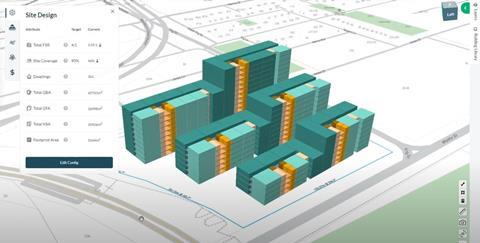In the second article of this series, Keir Regan-Alexander looks at ‘Auto Optioneering’ and its applicability to RIBA 0-1 / AIA PD

Many of the tools being developed in Generative Design for architecture bring the promise of far greater automation for capacity and feasibility study testing. The idea here is that you feed a Generative Design model your site constraints, planning/zoning rules, target accommodation brief and then let it run exhaustive tests on the many possible solutions it can find. The model configures pre-determined block typologies in novel configurations. The model then reports back numerically on the virtues of each arrangement. As each option emerges, it is reviewed against various desirable development metrics such as; efficiency, net area, daylight potential and even “walkability”. A menu is served to the user in the form of a shortlist which is rank ordered based on performance against each of the briefing KPIs; and the idea is that the design team will take it from there.
It seems to me that these tools will most likely be adopted directly by property/real estate developers to carry out their own simple site appraisal and briefing studies, before engaging an architect. This would mean that in the future, rather than receiving a written brief with a rough idea of what quantum the client hopes might be possible, they come instead with a fully formed three dimensional areas brief and a strong opinion about exactly how best to tackle the site. As the project is taken forward, all subsequent design work will likely be compared to the original target brief established by the Generative tool.
A substantial benefit to clients for this approach will be the ability to view a range of options with the same objective lens almost instantly. For example you will be able to assess very quickly a daylighting or sunlight potential design risk by A/B testing one version against another, as is made possible by Autodesk’s Forma. This could also put more power in the hands of planning authorities to assess designs against criteria that they care about most, or it may lend itself to a client wanting to optimise for particular attributes, for example; rooms with a “city view”. We already do this kind of thing in practice in a slow and analogue way, so these tools will allow for more-or-less instant prediction of the outcome as well as an ability to review new versions of designs against an original brief, to demonstrate incremental improvement.
Archistar, an Australian product has all site ownership boundaries predefined in parcels and when you click into them you can see the complete planning policy and development controls that apply to the site. The model understands these constraints automatically and stays within their bounds. This is a key benefit of a zoning approach to planning and one could imagine a similar “digital-first” approach to planning (and even public engagement) would hugely benefit developers looking to compose sites and planners looking to review schemes against policy and act as a single source of planning information.
The benefit of the approach also points to a difficulty. The geographical nuance around planning and development frameworks will be one of the main hurdles that start ups will need to overcome. Being able to scale a solution to many countries will be fundamental to the success of any such invention and is a cornerstone of venture investing. This means companies focusing on auto-optioneering tools will need to write general purpose tooling to work in every jurisdiction of every country. Therefore countries with highly localised planning policy and rather archaic, discretionary planning systems may be naturally harder to gain adoption in, because the planning system is inherently political and can’t always be boiled down to a line of policy (sound familiar?) …
In locations like London, development is also subject to Supplementary Planning Guidance, like the recently published Housing Design Standards LPG which place new requirements on development for design features like duel aspect homes. Such requirements can have a fundamental impact on the viability of a scheme at very early stages. This is one example of one change in one location that demonstrates that in reality every country would likely need their own development models that understand local policy.

Be Careful of:
A. Confusing “option viability” with good quality design.
The sheer simplicity of approach here makes products like Archistar & Delve feel inherently client friendly and would be a real cause for concern about the reduction of our role as architects, if we were to see wider adoption by clients. But arranging a brief in three dimensions is emphatically, not design. The models configure volumes, but they cannot judge the architectural design quality, urban suitability or desirability of a design, yet. They simply show a brief fitting into a box (which is no mean feat by the way). So for now, we may take a breath and reflect that while some of the taskwork being done here is similar to architecture, the quality architects bring in using their judgement to determine and realise actual value is not yet at risk. We should keep in mind however, that any design feature that we consider a signal of design quality, like “100% duel aspect”, that can be objectively boiled down to a rule, can just as easily be expressed in code.
B. Misleading KPIs.
Some products will compare eye-catching data indicators such as ‘walkability’, ‘net:gross efficiency’, ‘best overall’, or ‘best daylight’ performance. In reality, these are very nuanced issues that can’t easily be boiled down to singular KPIs and so easily compiled into a stack ranked table - if they could be, designers would have been out of the job long ago. Sure, one configuration may result in a more efficient use of land, but is the added area you’re winning in a particular option actually good area that people would want? Are you creating “walkable” places you’d actually want to walk in? Presenting data in this dumbed down way appears on the surface to bring value to users and the data is there so we may as well see it, it’s just very important to take it all with a large pinch of salt. Such numbers also present the risk of overpromising and under-delivering in practice. Clients may believe an area is eminently achievable based on such a tool and buy a site based in part upon this insight, only to find that when you add structures, mechanical and layouts people want to pay for - the area is unrealisable.
C. Generic Prototypes.
While there are exceptions, the majority of tools working in this area offer no ability to create or import your own building typologies for Generative Design testing. Looking ahead, architects and clients are going to want an ability to generate options from their own authored libraries and to be able to put their portfolio to use. Being able to build bespoke libraries within an organisation would allow users to run generative analysis on prototype configurations of their own making - an enhanced approach of user defined design rules that can then leverage the power of automated testing.
Consider, if everyone has access to the same generative development tools, templates and preset building libraries, do they really have an edge over their competitors when it comes to achieving greater development value? Finding value and area on tricky sites usually comes down to a unique site response that no one else could see.
>> Also read: The first movers creating Generative Design & AI tools for architecture
>> Also read: Generative Design & AI Trends: ‘Hybrid Collage’
>> Also read: Generative Design & AI Trends: ‘Leveraged Drafting’
Postscript
Keir Regan-Alexander is an AEC Domain Expert and Consulting Director operating at the intersection of architecture practice, sustainable development and software design. Connect on LinkedIn.
















No comments yet